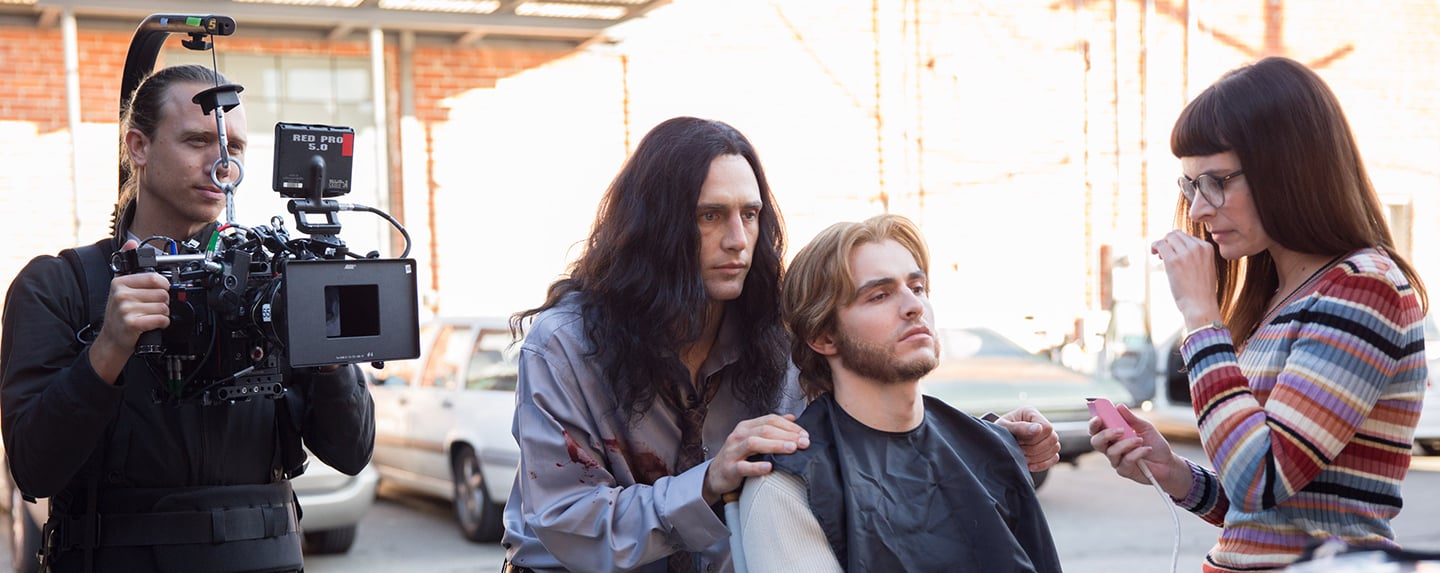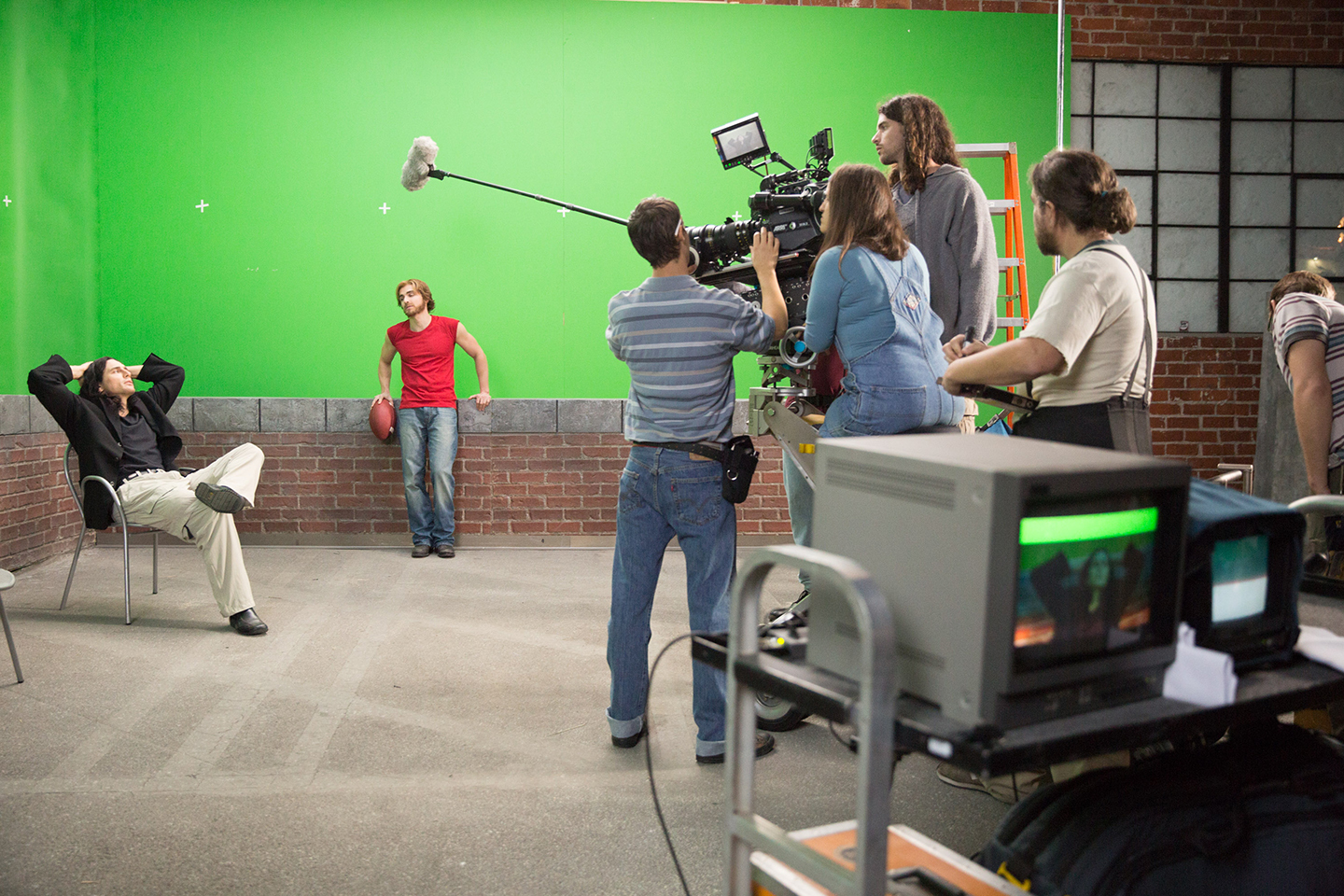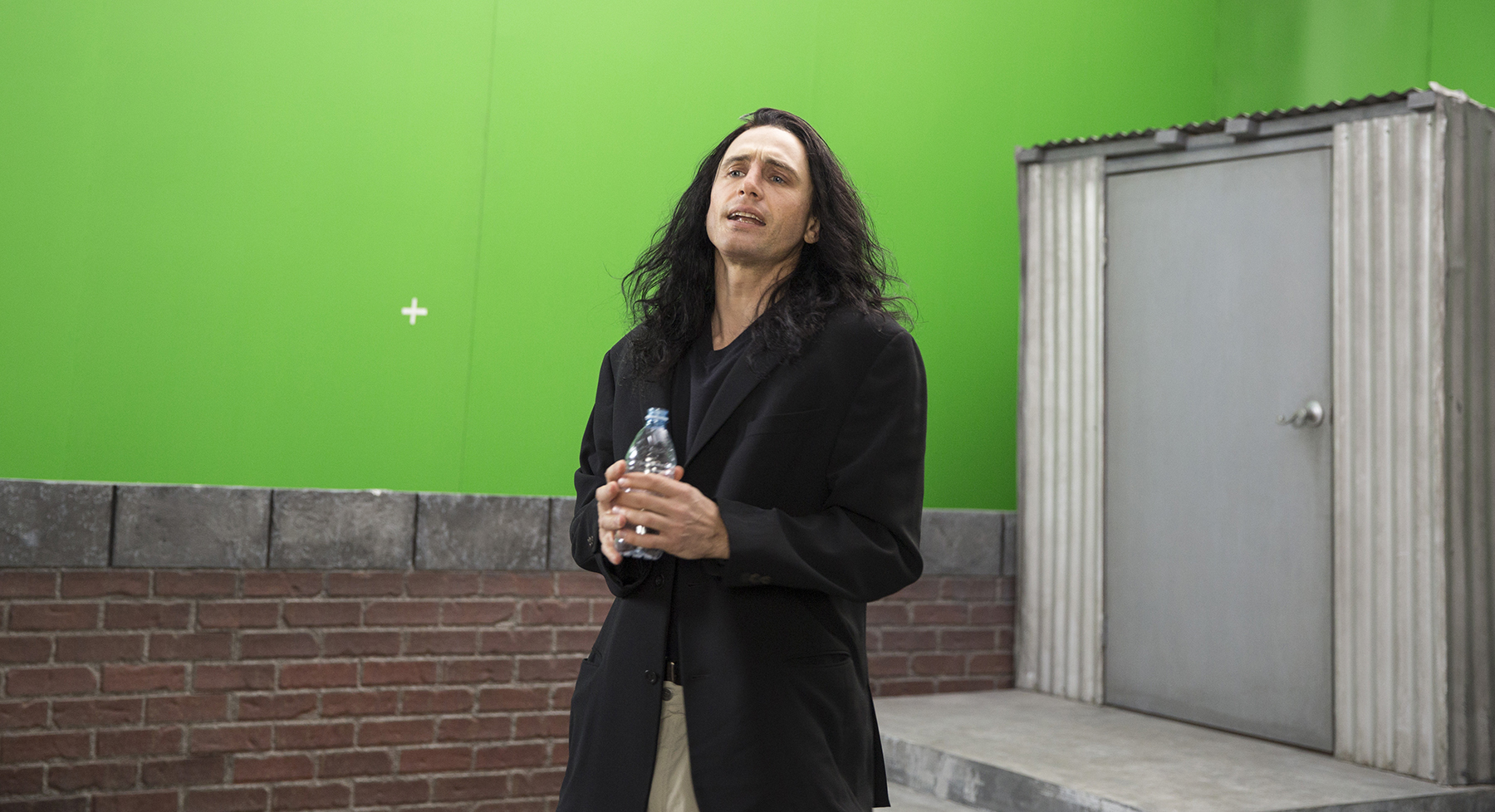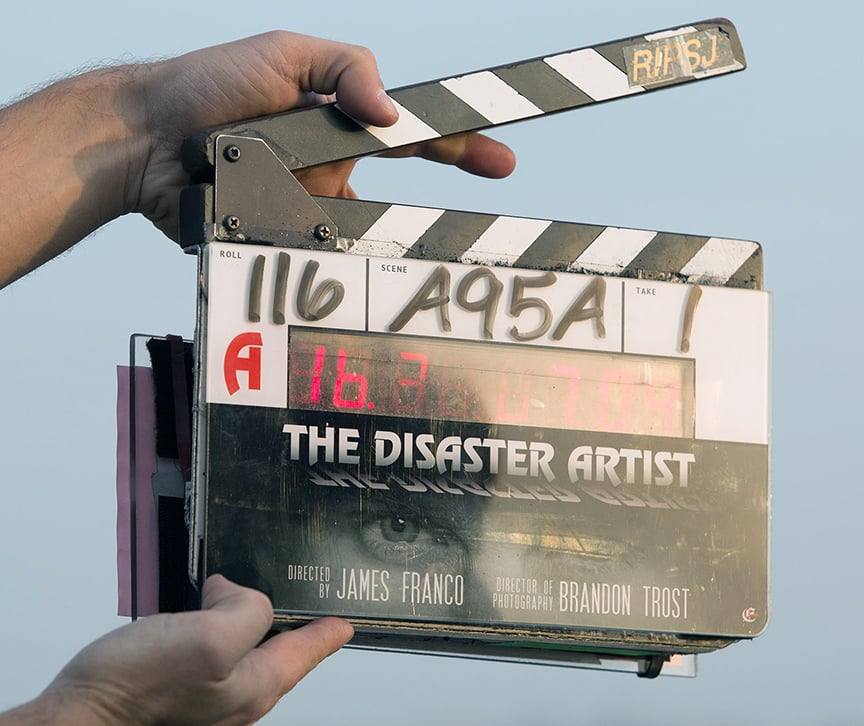
Burden of Dreams: The Disaster Artist
Cinematographer Brandon Trost teams with director-actor James Franco on this real-life tale of the making of an epically bad — and beloved — movie.
Cinematographer Brandon Trost teams with director-actor James Franco on this real-life tale of the making of an epically bad — and beloved — movie.
Unit photography by Justina Mintz, courtesy of A24
There’s a scene early in The Disaster Artist when aspiring actors Tommy Wiseau and Greg Sestero — portrayed by brothers James and Dave Franco, respectively — play a clumsy game of catch. They’re making plans to move to Los Angeles and become big movie stars, but Greg has some misgivings about their chances for success. “Don’t worry,” Wiseau drawls. He fumbles the football and returns it with a flimsy toss. “You just have to be the best you can be.”

This simple, naïve wisdom is all it takes to set the two men on the path that leads to The Room, Wiseau’s self-financed, $6 million independent feature debut — a film so epically ill-conceived it has been dubbed “the Citizen Kane of bad movies.” Even the real-life Sestero, who co-starred with Wiseau in The Room, came to embrace the comparison. In 2013, he co-wrote The Disaster Artist — his memoir of the making of the movie that, since its 2003 release, has inspired a devoted following and an ongoing slate of midnight screenings.

James Franco directed the feature adaptation of The Disaster Artist in addition to starring as Wiseau, and he tapped Brandon Trost to serve as director of photography. When AC spoke with Trost about his work on the film almost two years after it was finished, he was still high off the experience of, as he puts it, “being part of such an amazingly bonkers story.”

To be sure, audiences are drawn to The Room to bear witness to the unbelievable train wreck that unfolds on the screen. Despite its objective awfulness, however, the movie’s very existence is also proof that nothing is impossible if you believe in yourself. In telling the story of how The Room was made, The Disaster Artist both celebrates Wiseau’s ambition and revels in its folly.
American Cinematographer: You’ve said that you see The Disaster Artist as a drama disguised as a comedy. What do you mean by that?
Brandon Trost: The film, at its core, is a dramatic biopic — but it also has moments that seem so far from reality, all you can do is laugh. We wanted to tackle it like a dramatic film because it’s about two people who were just doing everything they could to follow their dreams. Granted, it’s funny by default because what happens is so crazy, but their struggle to make it in Hollywood is earnest and really relatable, so we wanted to make it feel real.

Real in what way?
We had a very short schedule, 27 days, with a ton of scenes and locations and actors. It felt like we wouldn’t have enough time to shoot this movie in a normal ‘Hollywood’ way, so I asked James if maybe we should go handheld, something more freeform — like a voyeuristic, documentary approach, but with a cinematic quality.
You and Franco have worked together before, on This Is the End and The Interview, but this is the first time he’s directed something you shot. How would you describe that relationship?
I feel like we were on the same page right from the start and it was a really organic collaboration. He put an amazing amount of care into the detail of his character and the story, and I felt a lot of trust and care put into my hands creatively as well. In prep we had homework assignments, where we’d watch movies and then talk about how they would relate to our film. We basically used The Wrestler [directed by Darren Aronofsky and shot by Maryse Alberti; AC Jan. ’09] as our touchstone for this documentary style. Digging deeper than that, we knew that Aronofsky was inspired by the Dardenne brothers’ films, and if you watch some of their films, you’ll see what he was after [in The Wrestler]. The Dardennes weren’t even in my canon. Franco told me about them, and I had to seek them out.

What was it about these films that inspired you?
There’s something gripping about the reality of The Wrestler, and we wanted to translate that to our reality. Also, there’s a beautiful ugliness to that movie, you know? The lighting is either too harsh, or too dark, or too bright — but it looks practical and has a certain intimacy that allows you to feel like you’re there. We wanted to apply that strategy to The Disaster Artist, which is all about this extreme human being, Tommy Wiseau.

What was it like working with a director who’s also starring in the movie as this extreme character who’s also a director and an actor?
Well, surreal, to say the least. There were moments when I would be operating and James would be in character as Wiseau, and we were both truly submersed in the narrative. It felt almost as if we were making this film from the inside looking out, instead of the usual experience directing and shooting more from the outside looking in. James was also in full makeup — fake chin, fake jaw, a piece on his eyelid, wig, contact lenses — every day before we started shooting, and he was still taking it off after everyone had left, so all we ever got to see was his weird version of Tommy. He wasn’t always in character between takes, but he was always doing Tommy’s voice. It was maybe stranger to see him out of makeup on the few days he wasn’t on the shooting schedule, when he was just being James the director.

How did you want to differentiate the cinema of The Room from your own movie?
It’s not like The Room is a great-looking movie, so when we emulate it [for a number of re-creations], it really feels like a low-budget movie, and The Disaster Artist feels like a different movie on top of it. In terms of lighting and tone, I wanted our movie to feel real, which is why we leaned towards The Wrestler and the Dardenne brothers, because those movies feel like the camera captures the perspective of someone who’s in the moment with these characters.
Was it a challenge to re-create the cinematography of The Room?
It was, and it was a fun challenge to be asked to make something look bad on purpose. For the scenes where they’re filming The Room, I’d set up our prop film and HD cameras [Ed. note: In typically outsize fashion, Wiseau elected to shoot The Room simultaneously on 35mm film and HD video], then find the frame that matched the shot from The Room, so that when we looked at the live video tap it’d be something we recognized. I had the movie on a laptop for reference; we’d check reflections in TVs and glasses in the shots from The Room to figure out what was lighting the scene. My gaffer and key grip, Justin Duval and Jon Coyne, would rough in their best guess, using whatever instruments it seemed would make the bad shadows and lighting. It always seemed counterintuitive, but that’s one of the things we liked about it. We’d tweak it from there, and that would also be the light that lit the scene for our cameras. I had watched some old BTS footage from The Room to check out what lights they used, and we mostly used the same — small Fresnel units and Kinos.
Did you get any input from people who worked on the original production?
Greg Sestero was always ready to help us understand the reality behind what we were doing, and some of our crew even worked on the original, adding a special meta twist to things. My DIT, Raul Riveros, is friends with Joe Pacella, who was the first AC for The Room. He even showed us some photos of their cameras, an Arriflex BL-4 and a Panasonic HDX900. We rented the same gear, with video taps because I wanted the feed from those cameras so I could move from the shot on the monitor to the actors’ faces. Those cameras were just props, really, but when they roll you can see the shutter spin in the tap and it feels like something is happening.

Did you find out what lenses they used?
From what we could tell, their BL-4 camera lens was an old 5:1 Cooke zoom. I tried to rent the same type of lens to match that optical quality, so we used the Panavision Z5S 5:1 Cooke zoom, 20-100mm, T3.1. We kept it on our prop camera when it was in-frame, and we’d pop it on our camera when it was time to shoot something from The Room.
What camera did you use?
I wanted a smaller camera because it’d be hanging off my back from an Easyrig for the whole shoot, so we shot with Red [Weapon] Dragons in anamorphic 6K, 2.39:1, onto 128GB cards. We shot spherical 5K, 1.85:1, for The Room [re-creations].
How did you approach the camera operating?
I operated with the camera completely disconnected from any wires so I could wander through the scene as the actors performed it. Whenever possible, operators B.J. McDonnell and Jesse Feldman would also be in play with longer lenses to catch some of our documentary-style moments. I would follow the scene in a master take, then go in for singles because we planned to break it up in the edit. Starting with that single-take energy ended up driving the whole flow of the movie. In fact, there are a handful of scenes where our editors actually used the long takes, like most of the scene where [James] Franco is walking around naked. I was stoked to see that they left those in.

What lenses did you use to shoot your movie?
I predominantly used Panavision C Series anamorphic lenses. I thought if we were going to be a little more rough-and-tumble, with that documentary edge, then anamorphic glass would make it feel more like a movie. We also used the Panavision close-focus [Macro Panatar 55mm] MAP55, which is one of my favorite lenses from The Diary of a Teenage Girl. I wanted to throw a little bit of chaos into the mix, using Tommy Wiseau as a point of departure. There’s this thing that Greig Fraser [ASC, ACS] did for Killing Them Softly [AC Oct ’12], where he had some high-speed anamorphics tweaked to shatter the bokeh a bit. Guy McVicker at Panavision Hollywood did it for us, a kind of de-tuning. I believe Fraser only used it for certain sequences in his movie, but I had Guy do it to every lens we had to maintain that look across the board. Speaking to that, first AC Markus Mentzer really had his work cut out for him. This adjustment is not an exact science; too much of a tweak will render the lens unusable, so you have to experiment to see what each lens can handle, and Markus helped dial them in nicely.
That reminds me of your method of stressing the camera sensors. You’re baking in these imperfections to add texture to the image.
I do that because I like to shoot in low light, and I like how that setting sort of tears the sensor apart, adding noise and increasing softness, which is something that helps me get that analog feel that’s so hard to emulate with digital cameras. I shot this movie at 3200 ISO, and I added some film grain in the color grade as well, to kind of mellow out the sensor noise and add some more of that analog flair. I’ve always been of the mind that the majority of a film’s look doesn’t come from the camera, anyway; it comes from the lenses.
What was your general approach to the movie’s lighting?
I start from the broad-stroke reality of the set, and play it as real as possible. We shot a couple of scenes at the Astro diner in [the Los Angeles neighborhood] Silver Lake, where we naturally had this mixed-color-temperature lighting, some hard sources, some soft, and just leaned into it. If we had something that was green or warm, I’d keep it. Sometimes we’d replace a bulb if we wanted to change the color, or diffuse a practical in the ceiling by taping some diffusion to it, but we almost never went beyond what was already there. We have this night-exterior scene in a parking lot, and it’s lit by a harsh mercury-vapor streetlight, which is just the light that was there. We actually had to turn off a few of the streetlights nearby because they were too bright. I didn’t use any fill or extra lights here, but I did have to fly a couple of large frames with either solids or Half Soft Frost behind camera just to help control camera shadows on the actors from distant streetlights. That’s the trick to working at such high ISO levels: It’s more about what lights you don’t use than what you do — and multiple light sources can become a mess real quick. Sometimes even practicals are too much, but if you can focus on what your key light is, you can use that to guide you through the scene. It’s a step back from traditional movie lighting, but in reality things aren’t always brightly lit.
Where did you do your color grade?
I worked with Doug Delaney at Deluxe in Culver City. He’s done most of the movies I shot with [The Disaster Artist producers] Seth Rogen and Evan Goldberg: Neighbors, Neighbors 2, The Interview and The Night Before. I wouldn’t say we tweaked it that much beyond what we were getting on the day. I knew I didn’t want a crisp black level. I don’t like when it’s set to zero, especially when I’m going for an analog feel; it feels too electronic for that slightly lifted ‘film black’ quality. It’s subjective, but I think it looks nice, and I’m always striving for softness, which is why I go for old lenses and stressing the lenses and camera beyond what they’re designed for — adding grain and using this mess of lighting.
It’s easy to talk about how bad The Room is, including its cinematography, but I wonder if maybe the cinematography is exactly what it should be. If the film looked any different, people might not love it as much.
Absolutely. The cinematography is a big part of the reason The Room is what it is. If it looked super-slick and crazy-professional and more expensive but had the same performances and story, I’m sure people would still think it was fun, but I’m not sure it would grab you to the same degree. There’s a strangeness to every single aspect of that movie, and that’s what makes it perfect.
You’ve said that The Disaster Artist is one of your favorite movies you’ve shot. Why is that?
I worked on super-small indie movies for almost 10 years before getting my first big gig, so this was my world. I know what it’s like to get in a van with three other people and that’s all the crew you have, and you’re working so endlessly hard to try to make something good without ever knowing if it will be good. It’s just the weird indie spirit of it all, making a movie because you can and because you need to. That’s part of the fun of this movie. It’s the story of these two guys who are following their dreams. Are they making something amazing? That’s debatable. But they do it, and maybe that’s all that matters.
This interview originally appeared in the January issue of American Cinematographer magazine.
TECHNICAL SPECS
2.39:1
Digital Capture
Red Weapon Dragon
Panavision C Series, E Series, G Series, Macro Panatar, Panafocal Zoom






